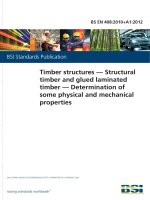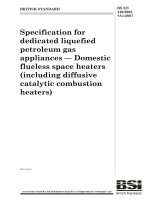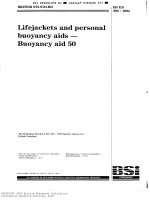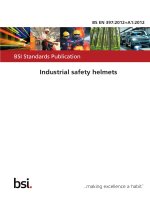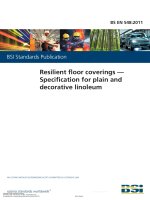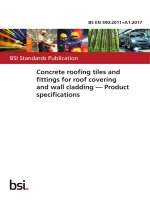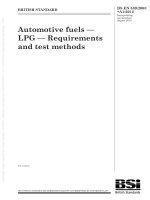Bsi bs en 01949 2011 + a1 2013
Bạn đang xem bản rút gọn của tài liệu. Xem và tải ngay bản đầy đủ của tài liệu tại đây (1.33 MB, 42 trang )
BS EN 1949:2011+A1:2013
BS EN 1949:2011
Standards
Publication
BSIBSI
Standards
Publication
Specification for the
installation of LPG systems
for habitation purposes in
leisure accommodation
vehicles and accommodation
purposes in other vehicles
NO COPYING
WITHOUT
BSI PERMISSION
AS PERMITTED
BY COPYRIGHT
NO COPYING
WITHOUT
BSI PERMISSION
EXCEPTEXCEPT
AS PERMITTED
BY COPYRIGHT
LAW LAW
™
™
raising
standards
worldwide
raising
standards
worldwide
BS EN 1949:2011+A1:2013
BRITISH STANDARD
National foreword
This British Standard is the UK implementation of EN 1949:2011+A1:2013.
It supersedes BS EN 1949:2011, which is withdrawn.
The start and finish of text introduced or altered by amendment is
indicated in the text by tags. Tags indicating changes to CEN text carry
the number of the CEN amendment. For example, text altered by
CEN amendment A1 is indicated by
The UK participation in its preparation was entrusted to Technical
Committee GSE/24, Dedicated LPG appliances.
A list of organizations represented on this committee can be obtained
on request to its secretary.
This publication does not purport to include all the necessary provisions
of a contract. Users are responsible for its correct application.
© The British Standards Institution 2013.
Published by BSI Standards Limited 2013
ISBN 978 0 580 79499 5
ICS 43.100; 97.200.30
Compliance with a British Standard cannot confer immunity
from legal obligations.
This British Standard was published under the authority of the
Standards Policy and Strategy Committee on 31 March 2011.
Amendments/corrigenda issued since publication
Date
Text affected
30 April 2013
Implementation of CEN amendment A1:2013
EUROPEAN STANDARD
EN 1949:2011+A1
NORME EUROPÉENNE
EUROPÄISCHE NORM
February 2013
ICS 43.100; 97.200.30
Supersedes EN 1949:2011
English Version
Specification for the installation of LPG systems for habitation
purposes in leisure accommodation vehicles and
accommodation purposes in other vehicles
Spécifications relatives aux installations des systèmes GPL
pour les besoins domestiques dans les véhicules habitables
de loisirs et dans les autres véhicules
Festlegungen für die Installation von Flüssiggasanlagen in
bewohnbaren Freizeitfahrzeugen und zu Wohnzwecken in
anderen Fahrzeugen
This European Standard was approved by CEN on 1 January 2011 and includes Amendment 1 approved by CEN on 24 December 2012.
CEN members are bound to comply with the CEN/CENELEC Internal Regulations which stipulate the conditions for giving this European
Standard the status of a national standard without any alteration. Up-to-date lists and bibliographical references concerning such national
standards may be obtained on application to the CEN-CENELEC Management Centre or to any CEN member.
This European Standard exists in three official versions (English, French, German). A version in any other language made by translation under
the responsibility of a CEN member into its own language and notified to the CEN-CENELEC Management Centre has the same status as the
official versions.
CEN members are the national standards bodies of Austria, Belgium, Bulgaria, Croatia, Cyprus, Czech Republic, Denmark, Estonia, Finland,
Former Yugoslav Republic of Macedonia, France, Germany, Greece, Hungary, Iceland, Ireland, Italy, Latvia, Lithuania, Luxembourg, Malta,
Netherlands, Norway, Poland, Portugal, Romania, Slovakia, Slovenia, Spain, Sweden, Switzerland, Turkey and United Kingdom.
EUROPEAN COMMITTEE FOR STANDARDIZATION
COMIT É E UROPÉ E N DE NORMALISAT ION
E UROPÄISCHE S KOMIT E E FÜR NORMUNG
Management Centre: Avenue Marnix 17, B-1000 Brussels
© 2013 CEN
All rights of exploitation in any form and by any means reserved worldwide
for CEN national Members.
Ref. No. EN 1949:2011+A1:2013: E
BS EN 1949:2011+A1:2013
EN 1949:2011+A1:2013 (E)
EN 1949:2011+A1:2013 (E)
Contents
Page
Foreword .......................................................................................................................................................4
1
Scope ................................................................................................................................................5
2
Normative references .......................................................................................................................5
3
Terms and definitions ......................................................................................................................6
4
4.1
4.2
4.3
4.3.1
4.3.2
4.4
General requirements .................................................................................................................... 10
General ........................................................................................................................................... 10
Dynamic loads ................................................................................................................................ 10
Tightness ........................................................................................................................................ 10
Requirements ................................................................................................................................. 10
Test ................................................................................................................................................. 10
Second LPG supply ....................................................................................................................... 10
5
5.1
5.2
5.3
5.4
5.5
5.6
5.7
Cylinder compartments ................................................................................................................. 10
General ........................................................................................................................................... 10
Cylinder compartments with internal access................................................................................ 12
Cylinders secured outside the vehicle .......................................................................................... 12
Requirements for the construction of cylinder compartments .................................................... 13
Ventilation for cylinder compartments .......................................................................................... 13
Cylinder compartments with internal access and low capacity cylinders................................... 13
Electric equipment in cylinder compartments .............................................................................. 14
6
6.1
6.2
6.3
6.4
6.5
6.6
Pressure regulation systems and working pressures .................................................................. 14
Pressure regulation systems ......................................................................................................... 14
Marking of the working pressure................................................................................................... 16
Devices to protect against over-pressure ..................................................................................... 16
Connection of pressure regulators to rigid pipework - Low pressure supply............................. 16
Connection of a dual cylinder system........................................................................................... 16
Connection of an external LPG supply by means of a plug-in connector ................................... 16
7
7.1
7.2
7.3
7.4
7.5
7.6
Components ................................................................................................................................... 18
Hoses/Hose assemblies................................................................................................................. 18
Pipes ............................................................................................................................................... 18
Pipe fittings .................................................................................................................................... 19
Jointing materials........................................................................................................................... 21
Shut-off valves ............................................................................................................................... 21
Manual change over valve ............................................................................................................. 21
8
8.1
8.2
8.3
8.4
8.5
8.6
8.7
8.8
8.9
Installation design .......................................................................................................................... 21
General ........................................................................................................................................... 21
Protection against mechanical damage ........................................................................................ 22
Avoidance of corrosion ................................................................................................................. 22
Pipe sizing ...................................................................................................................................... 22
Pipe fittings .................................................................................................................................... 22
Positioning of LPG pipes near to other services .......................................................................... 22
Fixing .............................................................................................................................................. 22
Shut-off valves ............................................................................................................................... 22
Equipotential bonding of LPG pipes ............................................................................................. 23
9
Connection of appliances to the LPG supply installation ............................................................ 23
10
10.1
10.2
Appliances ...................................................................................................................................... 24
Suitability of appliances ................................................................................................................ 24
Installations .................................................................................................................................... 24
2
BS EN 1949:2011+A1:2013
EN 1949:2011+A1:2013 (E)
EN 1949:2011+A1:2013 (E)
10.3
10.3.1
10.3.2
10.4
10.4.1
10.4.2
10.5
10.6
10.7
10.8
10.9
Space heaters .................................................................................................................................24
Space heating appliances in caravans, motor caravans and other road vehicles ......................24
Space heating appliances in caravan holiday homes...................................................................24
Water heaters .................................................................................................................................25
Water heaters in caravans, motor caravans and other road vehicles..........................................25
Water heaters in caravan holiday homes ......................................................................................25
Cooking appliances........................................................................................................................26
Refrigerators...................................................................................................................................26
Gas lights........................................................................................................................................26
LPG fuel cells .................................................................................................................................26
LPG power generators ...................................................................................................................26
11
11.1
11.2
11.3
11.4
11.5
Flueing ............................................................................................................................................27
Flues ...............................................................................................................................................27
Flue terminals .................................................................................................................................27
Weather protection .........................................................................................................................29
Draught diverters ...........................................................................................................................29
Accessibility of flues ......................................................................................................................29
12
12.1
12.2
Installation of LPG tanks supplying LPG appliances ...................................................................29
Requirements regarding the LPG tank and accessories ..............................................................29
Installation of the LPG tank and system requirements ................................................................30
13
User’s handbook ............................................................................................................................31
Annex A (informative) National situations in the Member States ..............................................................33
Annex B (informative) Countries where underfloor flue is not permitted ................................................34
Annex C (informative) Manufacturer declaration .......................................................................................35
Bibliography................................................................................................................................................37
3
BS EN 1949:2011+A1:2013
EN 1949:2011+A1:2013 (E)
EN 1949:2011+A1:2013 (E)
Foreword
This document (EN 1949:2011+A1:2013) has been prepared by Technical Committee CEN/TC 181
“Dedicated liquefied petroleum gas appliances”, the secretariat of which is held by AFNOR.
This European Standard shall be given the status of a national standard, either by publication of an identical
text or by endorsement, at the latest by August 2013, and conflicting national standards shall be withdrawn at
the latest by August 2013.
Attention is drawn to the possibility that some of the elements of this document may be the subject of patent
rights. CEN [and/or CENELEC] shall not be held responsible for identifying any or all such patent rights.
This document includes Amendment 1 approved by CEN on 24 December 2012.
This document supersedes !EN 1949:2011".
The start and finish of text introduced or altered by amendment is indicated in the text by tags !".
Principal changes made to EN 1949:2002 and EN 1949:2002/A1:2005:
a)
more than one gas supply is permitted in a vehicle;
b)
hard soldering redefined;
c)
the provision of a certificate of tightness testing is no longer mandated;
d)
tightness criteria for high pressure parts of the gas system not verified in the standard tightness test are
specified;
e)
requirements for electric cables in gas cylinder compartments have been revised;
f)
lengths of hoses and hoses assemblies have been clarified;
g)
basic requirements for installation of fuel cells added;
h)
basic requirements for installation of power generators added (including second supply line);
i)
requirements for plug in connector gas supplies added;
j)
options for new member states added;
k)
requirements for LPG tank installation added.
According to the CEN/CENELEC Internal Regulations, the national standards organizations of the following
countries are bound to implement this European Standard: Austria, Belgium, Bulgaria, Croatia, Cyprus, Czech
Republic, Denmark, Estonia, Finland, Former Yugoslav Republic of Macedonia, France, Germany, Greece,
Hungary, Iceland, Ireland, Italy, Latvia, Lithuania, Luxembourg, Malta, Netherlands, Norway, Poland, Portugal,
Romania, Slovakia, Slovenia, Spain, Sweden, Switzerland, Turkey and the United Kingdom.
4
BS EN 1949:2011+A1:2013
EN 1949:2011+A1:2013 (E)
EN 1949:2011+A1:2013 (E)
1
Scope
This European Standard specifies the requirements for the installation of liquefied petroleum gas systems for
habitation purposes in leisure accommodation vehicles and for accommodation purposes in other vehicles. It
details safety and health requirements on the selection of materials, components and appliances, on design
considerations and tightness testing of installations and on the contents of the user's handbook.
rd
This European Standard does not cover installations supplied from other than 3 family gases (LPG), water
connections or electrical power supplies to the appliance(s). Portable appliances, incorporating their own gas
supply, are not considered part of the installation and are outside the scope of this standard. It does not
include the installation of LPG appliances to be used for commercial purposes or for boats. Gas supply
equipment and gas appliances separate from and external to the body of the vehicle are also not considered
by this standard.
2
Normative references
!The following documents, in whole or in part, are normatively referenced in this document and are
indispensable for its application. For dated references, only the edition cited applies. For undated references,
the latest edition of the referenced document (including any amendments) applies."
EN 331, Manually operated ball valves and closed bottom taper plug valves for gas installations for buildings
EN 624, Specification for dedicated LPG appliances — Room sealed LPG space heating equipment for
installation in vehicles and boats
EN 732, Specifications for dedicated liquefied petroleum gas appliances — Absorption refrigerators
EN 751-2, Sealing materials for metallic threaded joints in contact with 1st, 2nd and 3rd family gases and hot
water — Part 2: Non-hardening jointing compounds
EN 1057, Copper and copper alloys — Seamless, round copper tubes for water and gas in sanitary and
heating applications
EN 1254-1, Copper and copper alloys — Plumbing fittings — Part 1: Fittings with ends for capillary soldering
or capillary brazing to copper tubes
EN 1254-2, Copper and copper alloys — Plumbing fittings — Part 2: Fittings with compression ends for use
with copper tubes
EN 1254-4, Copper and copper alloys — Plumbing fittings — Part 4: Fittings combining other end connections
with capillary or compression ends
EN 10226-1, Pipe threads where pressure tight joints are made on the threads — Part 1: Taper external
threads and parallel internal threads — Dimensions, tolerances and designation
EN 10305-1, Steel tubes for precision applications — Technical delivery conditions — Part 1: Seamless cold
drawn tubes
EN 10305-2, Steel tubes for precision applications — Technical delivery conditions — Part 2: Welded cold
drawn tubes
EN 12864:2001, Low pressure, non adjustable regulators having a maximum outlet pressure of less than or
equal to 200 mbar with a capacity of less than or equal to 4 kg/h, and their associated safety devices for
butane, propane or their mixtures
EN 12979:2002, Automotive LPG-systems — Installation requirements
5
BS EN 1949:2011+A1:2013
EN 1949:2011+A1:2013 (E)
EN 1949:2011+A1:2013 (E)
EN 13785, Regulators with a capacity of up to and including 100 kg/h, having a maximum nominal outlet
pressure of up to and including 4 bar, other than those covered by EN 12864 and their associated safety
devices for butane, propane or their mixtures
EN 13786:2004+A1:2009, Automatic change-over valves having a maximum outlet pressure of up to and
including 4 bar with a capacity of up to and including 100 kg/h, and their associated safety devices for butane,
propane or their mixtures
EN 14291, Foam producing solutions for leak detection on gas installations
EN 15033, Room sealed storage water heaters for the production of sanitary hot water using LPG for vehicles
and boats
EN ISO 1127, Stainless steel tubes — Dimensions, tolerances and conventional masses per unit length
(ISO 1127:1992)
EN ISO 8434-1, Metallic tube connection for fluid power and general use — Part 1: 24 degree cone
connectors (ISO 8434-1:2007)
ISO 8434-2, Metallic tube connections for fluid power and general use — Part 2: 37 degree flared connectors
UN/ECE Regulation No. 67-01: Uniform provisions concerning the approval of motor vehicles using LPG in
their propulsion system
3
Terms and definitions
For the purposes of this document, the following terms and definitions apply.
3.1
leisure accommodation vehicle
unit of living accommodation for temporary or seasonal occupation that may meet requirements for
construction and use of road vehicles
[EN 13878]
3.2
caravan
trailer leisure accommodation vehicle that meets requirements for construction and use of road vehicles
[EN 13878]
3.3
motor caravan
self-propelled leisure accommodation vehicle that meets requirements for construction and use of road
vehicles. It contains at least seats and table, sleeping accommodation which may be converted from the
seats, cooking facilities and storage facilities
[EN 13878]
3.4
caravan holiday home
transportable leisure accommodation vehicle that does not meet requirements for construction and use of
road vehicles, that retains means for mobility and is for temporary or seasonal occupation
[EN 13878]
6
BS EN 1949:2011+A1:2013
EN 1949:2011+A1:2013 (E)
EN 1949:2011+A1:2013 (E)
3.5
liquefied petroleum gas (LPG)
!mixture of light hydrocarbons composed mainly of propane, butane and their isomers, gaseous under
conditions of normal temperature and pressure
Note 1 to entry:
LPG is maintained in its liquid state by increased pressure or lowered temperature."
!Note 2 to entry: "
In some countries, UN numbers 1011 and 1978 may also be designated LPG.
3.6
LPG appliance
appliance that is designed for heating, cooking, lighting, refrigeration, hot water production or electricity
production (fuel cell or generator), using LPG as its energy source
3.7
LPG system
assembly of an installation and its appliances
3.8
liquefied petroleum gas installation
installation usually consisting of fuel container(s), pressure regulator(s), piping, hoses and shut-off devices,
providing liquefied petroleum gas to appliances
3.9
pressure regulation system
!system incorporating one or more regulators with or without change-over device to reduce the supply
pressure of the system to the required working pressure for the appliance(s)"
!3.10
regulator
device which maintains a regulated pressure within preset limits, whatever the upstream pressure, rate and
temperature"
3.11
!change over device
device which maintains the gas supply continuity by using gas from a "cylinder", a "tank" or an external supply
manually chosen by the user or automatically"
!3.12
room sealed appliance
appliance that has the combustion system, including the air inlet and products outlet, isolated from any
internal area
3.13
open-flue appliance
appliance designed to be connected to a flue via a draught diverter, its combustion air being drawn from the
room or internal space in which it is installed"
!3.14"
closed-flue appliance
appliance where the flue is closed from a room or internal space due to the absence of a draught diverter, flue
break and any draught break within the flue
!3.15"
flueless appliance
appliance that discharges its products of combustion into the compartment in which it is installed
7
BS EN 1949:2011+A1:2013
EN 1949:2011+A1:2013 (E)
EN 1949:2011+A1:2013 (E)
!3.16"
flue
duct designed to convey the products of combustion to the exterior of a vehicle
!3.17"
flue terminal
part of the flue system through which the products of combustion are discharged to the outside (cowl)
!3.18"
shut-off valve
device to interrupt the flow of gas, having one inlet and one or more individually controlled outlets
!3.19"
liquefied petroleum gas cylinder
portable container for liquefied petroleum gas
[EN 13878]
!3.20"
cylinder compartment
space specially constructed to accommodate one or more liquefied petroleum gas cylinders
!3.21"
flame supervision device
device that has a sensing element, activated by the presence or absence of a flame, that causes the inlet of
the LPG supply to a burner to be opened or closed
!3.22"
pilot
small burner that provides a continuously burning flame to ignite a main burner when required
!3.23"
tightness
absence of leakage greater than the specified limit
!3.24"
hard soldering
soldering for which the lowest temperature of the melting range, after application, is not less than 450 °C
!3.25"
fixed ventilation
permanent measures that ensure the minimum provision of fresh air
!3.26"
free area of ventilation
total area of the apertures in a ventilator or grill
!3.27"
ventilator
device that allows the passage of air for the ventilation of a compartment
!3.28"
hose assembly
length of hose with suitably attached end fittings
[EN ISO 14113]
8
BS EN 1949:2011+A1:2013
EN 1949:2011+A1:2013 (E)
EN 1949:2011+A1:2013 (E)
!3.29"
low pressure hose assembly
hose assembly, LPG resistant, for use at working pressure
!3.30"
high pressure hose assembly
hose assembly, LPG resistant, for use at high pressure, normally supply pressure
!3.31"
change-over device
device to allow selective use of interconnected LPG cylinders
!3.32"
users handbook
document that provides information to the user of a leisure accommodation vehicle on its operation,
maintenance, repair etc.
!3.33"
working pressure
pressure at the inlet of a LPG appliance while it is in operation
!3.34"
readily accessible
item capable of being reached quickly and safely for effective use under emergency conditions without the use
of tools
NOTE
The key of a lock is not regarded as a tool.
!3.35"
accessible
item capable of being reached for inspection, removal or maintenance with or without the use of tools
!3.36"
safety closing device
device which automatically interrupts the flow of gas due to an accidental disconnection of a hose or pipe
!3.37"
LPG tank
storage receptacle permanently fixed to the vehicle, suitable for the storage of LPG
NOTE
This may supply LPG for gas appliances only.
!3.38"
underfloor flue
flue which discharges all or parts of the products of combustion into the space lying beneath and within the
plan view of the vehicle
!3.39"
consumer leak detection device
device capable of indicating any downstream leakage
9
BS EN 1949:2011+A1:2013
EN 1949:2011+A1:2013 (E)
EN 1949:2011+A1:2013 (E)
4
General requirements
4.1
General
The manufacturer or installer of an LPG system may issue a declaration for each leisure accommodation
vehicle or other vehicle stating the compliance with EN 1949, including the test result of 4.3.2, it should
include the information shown in Annex C.
4.2
Dynamic loads
The LPG system shall be designed to withstand the dynamic loads during normal operation including
movement of the vehicle and to fulfil the operational requirements of the appliances.
4.3
Tightness
4.3.1
Requirements
The LPG system up to the consumer operated controls of the appliances (taps) shall fulfil the following
tightness requirements if tested at a test pressure of 150 mbar with air. The decrease in pressure shall not
exceed 10 mbar for a test volume of at least 700 cm3. If necessary, an additional test volume of 600 cm3
should be used.
4.3.2
Test
The test is carried out with air using the following procedure. In preparation for the test the taps of the
appliances shall be closed but the shut off valves be left open. The system is then pressurized to 150 mbar
and closed. After a period of 5 min to allow for temperature equilibrium, the pressure is recorded. After
another 5 min the remaining pressure is compared to the first pressure.
All parts of the LPG system operating at pressures above working pressure, if any, are tested with an
appropriate leak detection solution according to EN 14291 at operational pressure, no leakage shall be
observed within 30 s.
4.4
Second LPG supply
Only if a LPG power generator is installed and the total gas consumption including the appliances exceeds
1,5 kg/h it is allowed to install one additional gas supply.
There shall be no connection between the both gas supplies.
The cylinder(s) for both gas supplies can be installed in the same cylinder compartment.
If two cylinder compartments are used, there shall be a warning sign inside both the compartments which
advises the user that there is a second gas supply.
!Inside the cylinder compartment it shall be clearly indicated by a label which appliances are supplied by
each gas supply."
5
5.1
Cylinder compartments
General
For road going vehicles cylinders shall be installed in cylinder compartments, except when they are installed
according to 5.3 or when they are used in the conditions of 6.6.
10
BS EN 1949:2011+A1:2013
EN 1949:2011+A1:2013 (E)
EN 1949:2011+A1:2013 (E)
With the exception of 5.2 and 5.6 cylinder compartments shall be sealed against the accommodation space
and shall have external access only. Any cylinder placement shall provide a minimum distance from the
engine exhaust system as shown in Figure 1.
a) Top view
b) Side view
Key
1
2
3
4
example of allowed position of the exhauster
LPG cylinder compartment
LPG cylinders
outside the vehicle
R = D = D1 ≥ 250 mm
D2 ≥ 300 mm
The shaded areas represent the volume where no part of exhaust system shall be located without installation of the
protection shield.
Figure 1 — Minimum distance from the engine exhaust system
11
BS EN 1949:2011+A1:2013
EN 1949:2011+A1:2013 (E)
EN 1949:2011+A1:2013 (E)
!Alternatively, thermal shielding shall be installed to prevent entry of exhaust heat gases into the
compartment, or projection of the exhaust heat flow towards the cylinder(s) (see Figure 2)."
Key
1 exhauster
2 LPG cylinder compartment
3 LPG cylinders
4 outside the vehicle
5 inside the vehicle
6 ventilation
7 driving direction
8 thermal shielding
E ≥ 25 mm
Figure 2 — Example of shielding that can be installed
Dimension E shall not be smaller than 25 mm. The minimum area of low level ventilation shall be maintained,
as specified in 5.5.
NOTE
5.2
In Figure 2, the area of low level ventilation is based on 10 000 mm2.
Cylinder compartments with internal access
For motor caravans and other vehicles where penetration of a type approved base vehicle bodywork would be
required to provide external access, internal access to the compartment is permitted provided the following
conditions are met:
a)
the compartment can contain a maximum of two cylinders, each having a capacity of not more than
16 kg;
b)
access between the compartment and the habitable area is only provided via an attached sealed door or
hatch, the bottom edge of which is not less than 50 mm above the compartment floor.
5.3
Cylinders secured outside the vehicle
For vehicles of category N of Directive 2007/46/EC support shall be provided to secure cylinders outside the
vehicle, but within the body contour unless a compartment complying with 5.2 is provided.
12
BS EN 1949:2011+A1:2013
EN 1949:2011+A1:2013 (E)
EN 1949:2011+A1:2013 (E)
The requirements of 5.4 also apply.
5.4
Requirements for the construction of cylinder compartments
The cylinder compartment shall be designed so that:
a)
cylinders can be secured rigidly in an upright position with the valve uppermost to operate only in the
gaseous phase to prevent inadvertent movement when the vehicle is in motion. For this purpose there
shall be means of securing the cylinders at high and low level;
NOTE
A pull-out tray for the placement of the cylinder(s) is permitted inside the cylinder compartment to facilitate the
exchange of cylinders.
b)
access to any connections, changeover devices and pressure regulation systems is not obstructed;
c)
the replacement of cylinders can be made without disturbing the installation or ancillary equipment;
d)
it is possible for any cylinder securing device to be opened and closed without the use of tools.
!A label shall be placed with a pictogram of a cylinder and a warning sign "read instructions", see Figure 3,
in the vicinity of the cylinder(s)."
Figure 3 — warning sign "read instructions"
5.5
Ventilation for cylinder compartments
Permanent ventilation of any cylinder compartment shall be provided to the exterior.
If the ventilation is provided only at low level, the free area shall be at least 2 % of the compartment floor area
with a minimum of 10 000 mm2. If the ventilation is provided at high and low level the free area shall be at
least 1 % of the compartment floor area at each level and not less than 5 000 mm2 at each level. It shall not
be possible for any part of the ventilation area to be obstructed by a cylinder.
!NOTE Low level means in the floor, or if in the side wall touching the floor. The longer dimension of the ventilation is
on the floor level"
5.6
Cylinder compartments with internal access and low capacity cylinders
The fixed ventilation for cylinder compartments complying with 5.2 may be provided via one vent provided the
following conditions are complied with:
a)
the compartment can contain a maximum of two cylinders with a maximum combined capacity of 7 kg;
b)
the vent shall have a minimum internal diameter of 20 mm;
c)
where a duct is attached to the ventilation opening the maximum length of the duct shall not exceed
5 times the internal diameter of the duct. It may be extended to ten times the internal diameter of the duct,
if it is necessary, to avoid interference with under floor flue outlets;
d)
the duct shall be positioned at low level in the floor and be resistant to LPG;
13
BS EN 1949:2011+A1:2013
EN 1949:2011+A1:2013 (E)
EN 1949:2011+A1:2013 (E)
e)
the duct shall fall throughout its entire length to the outside of the vehicle.
5.7
Electric equipment in cylinder compartments
No electrical equipment including wiring systems, except:
a)
ELV (extra low voltage) equipment for gas supply control;
b)
cables running through a gas compartment without connection
shall be installed in any gas cylinder compartment.
Such electrical installations and components shall be constructed and installed so that they are not a potential
source of ignition.
Where cables have to run through such a compartment such cables shall be protected against mechanical
damage by installation within conduit or duct passing through the compartment.
Where installed in a position where it is likely to be subject to mechanical damage this conduit or duct shall be
able to withstand an impact equivalent to AG3.
6
Pressure regulation systems and working pressures
6.1
Pressure regulation systems
6.1.1
The LPG installation shall have a pressure regulation system installed.
!Pressure regulation systems in road vehicles shall have a fixed working pressure of 30 mbar and comply
with EN 12864:2001 (Annex D or Annex M with a maximum flow rate of 1,5 kg/h). Automatic change-over
devices in vehicles shall comply with EN 13786:2004+A1:2008 (Annex B or Annex J with a maximum flow rate
of 1,5 kg/h). For each LPG supply (if a second gas supply exists) the flow rate of the pressure regulation
system shall be at least the maximum capacity of the concerned installation, including all appliances installed
by the manufacturer."
For caravan holiday homes with LPG cylinder supply, the pressure regulation system shall comply with either
EN 12864, EN 13785 and/or EN 13786. If applicable, national regulations for LPG installations shall be
considered.
Where a cylinder compartment is provided it shall be designed to contain the pressure regulation system. The
pressure regulation system shall be designed either to be fitted:
a)
directly to the LPG cylinder valve;
b)
remote from the cylinders; then the connection shall be a high pressure flexible hose assembly with a
+ 50
length of (400 −100 ) mm;
c)
where a pull-out tray for the placement of cylinders is provided and the regulation system is mounted at
the wall, a maximum length of 750 mm hose assembly is permitted. It shall not be possible to create any
strain in the gas supply hose assembly when the tray is pulled out. If the regulation system is installed on
a pull-out tray (see Figure 4); then the connection shall be a high pressure flexible hose assembly with a
+ 50
length of (400 −100 ) mm.
14
BS EN 1949:2011+A1:2013
EN 1949:2011+A1:2013 (E)
EN 1949:2011+A1:2013 (E)
Key
1
2
3
4
5
6
7
cylinder(s)
high pressure hose(s)
pressure regulation system
rigid piping
low pressure hose
pull-out tray
cylinder compartment
Figure 4 — Example of positions of pressure regulation systems and hose assemblies on a cylinder
pull-out tray
Where the pressure regulation system is mounted remote from the cylinder the connection shall be designed
to prevent accidental loosening and it shall not be possible to apply strain to the hose or connections when
changing cylinders.
The hose assembly shall be free from strain when connected to the size(s) of gas cylinder stated in the users
handbook. The pressure regulation system shall be located so, that the hose assembly rises continuously
throughout its length from the cylinder outlet to the pressure regulation system inlet.
A suitable connection point for test equipment shall be provided to verify the tightness of the gas system from
the outlet of the regulator to the inlet of the appliances.
6.1.2 Pressure regulation systems installed on the outside of the vehicle without housing shall have the
vents protected against the ingress of dirt and water by positioning or covers.
15
BS EN 1949:2011+A1:2013
EN 1949:2011+A1:2013 (E)
EN 1949:2011+A1:2013 (E)
6.1.3
!If the heating system or any other appliance is intended for use while the vehicle is in motion
there shall be means to prevent uncontrolled release of LPG due to accidental disconnection (according to the
European Directive 2006/119/EC)."
NOTE
6.2
There are two alternative types of safety closing devices:
excess flow valves, which close when a specific flow of LPG is reached, or
crash sensor activated valve, which detects an abnormal acceleration/deceleration of the vehicle (accident)
and closes the LPG supply by means of an automatic valve.
Marking of the working pressure
Each supply line shall be permanently identified with a label in the vicinity of the connection to the pressure
regulation system with the working pressure in mbar.
6.3
Devices to protect against over-pressure
For vehicles a device/devices shall be provided within the installation or integral with the pressure regulation
system to ensure that a pressure greater than 150 mbar is not supplied to any appliance.
Where an over-pressure relief valve is fitted it shall vent into the cylinder compartment or directly to the
outside of the vehicle.
6.4
Connection of pressure regulators to rigid pipework - Low pressure supply
Low pressure flexible hoses with a maximum length of (400
+ 50
−100
) mm may be fitted between pressure
regulators and the rigid pipework within the LPG cylinder compartment. Where a pull-out tray for the
placement of cylinders is provided, a maximum length of 750 mm hose is permitted. It shall not be possible to
create any strain in the low pressure flexible hose when the tray is pulled out.
NOTE
Where the pressure regulation system is mounted on a pull-out tray (according to 6.1.1 c) the use of rigid
piping between the outlet of the pressure regulation system and the end of the pull-out tray is permitted.
6.5
Connection of a dual cylinder system
Changeover devices for the connection of a dual cylinder system shall be provided with an automatic device
to prevent the escape of gas when either cylinder is disconnected.
6.6
Connection of an external LPG supply by means of a plug-in connector
If a plug-in connector for the connection of an external LPG supply is fitted in addition to an internal supply it
shall be permanently fixed and a change over valve shall be installed which enables one of the two LPG
sources (external or onboard). In the vehicle installation a connection according to Figure 5 (EN 561) shall be
installed upstream of the regulator (wall mounted). A manual change over valve shall be installed according to
Figure 6 to prevent the flow of gas in the direction of the cylinder valve in case of external supply and to
prevent the flow of gas in the direction of the external supply connection in case of internal supply.
16
BS EN 1949:2011+A1:2013
EN 1949:2011+A1:2013 (E)
EN 1949:2011+A1:2013 (E)
1) The minimum hardness of the male element surface is 270 HV10 for a minimum length of 15,2 mm.
2) The internal diameter C shall be for a minimum length of 20 mm.
Dimensions and tolerances of coaxiality and perpendicularity in millimeters, surfaces roughness values in micrometers
Key
A
B
C
h10, 7,3 mm
h10, 12,3 mm
JS13, 5 mm
Figure 5 — male connector 0,5 bar
The dimensions and fabrication details not specified in Figure 5 are left to the discretion of the manufacturer,
with the proviso that quick-action couplings with shut-off valves of the same type shall be interchangeable,
regardless of their manufacturer.
17
BS EN 1949:2011+A1:2013
EN 1949:2011+A1:2013 (E)
EN 1949:2011+A1:2013 (E)
Key
1
2
cylinder
hose
!
3
4
5
6
7
change over device"
regulator
piping according 7.2
plug in socket
external LPG supply
Figure 6 — Connection of an external LPG supply 0,5 bar
The inlet pressure of the external supply shall not be lower than 0,3 bar and not exceed 0,5 bar. The inlet
connection shall be marked with “LPG inlet max 0,5 bar”.
The plug-in connector shall be incompatible with any external outlet connection (see 9.7).
The plug-in connector shall be protected against dirt by means of cover.
If the plug-in connector is fitted inside the cylinder compartment it shall be possible to make up the connection
to the system and subsequently to close the cylinder compartment door without causing any damage to the
supply hose.
7
7.1
Components
Hoses/Hose assemblies
Only hoses and hose assemblies appropriate for the first country of sale (e.g. temperature resistance, colour
coding) complying with the requirements of that country shall be provided.
7.2
Pipes
Pipes shall be made of copper complying with EN 1057, seam welded steel complying with EN 10305-2,
seamless steel complying with EN 10305-1 or stainless steel complying with EN ISO 1127 and shall have a
minimum nominal wall thickness in compliance with Table 1:
18
BS EN 1949:2011+A1:2013
EN 1949:2011+A1:2013 (E)
EN 1949:2011+A1:2013 (E)
Table 1 —Minimum nominal wall thickness of pipes
Outer diameter
mm
6
8
10
12
15a
18a
22a
Copper
Steel
0,6
0,8
1,0
1,0
1,0
1,0
1,0
0,5
0,8
1,0
1,0
1,0
1,0
1,0
a
For caravan holiday homes the above values for wall thickness are recommended, but it is acceptable
in countries where National Standards permit, to use a different wall thickness in accordance with
EN 1057.
7.3
7.3.1
Pipe fittings
Metallic fittings shall be of the following types (see Figure 7).
19
BS EN 1949:2011+A1:2013
EN 1949:2011+A1:2013 (E)
EN 1949:2011+A1:2013 (E)
a) Cutting ring type fitting
b) Capillary type fitting
c) Flared type fitting
d) Compression fitting
e) Threaded fitting for nozzle
Figure 7 — Permitted pipe fittings
20
BS EN 1949:2011+A1:2013
EN 1949:2011+A1:2013 (E)
EN 1949:2011+A1:2013 (E)
7.3.2
In addition, the following requirements shall apply:
fittings using rubber or plastic seals shall be used only for the connection of cylinders and pressure
regulating systems;
plastic fittings shall not be used;
dimensions of cutting ring fittings shall comply with EN ISO 8434-1;
where cutting ring fittings are used in conjunction with copper pipe, a brass insertion sleeve and brass
cutting ring shall be fitted unless copper pipe complying to EN 1057, specification R 290 is used. When
using cutting rings all components shall be matched, i.e. of the same series;
capillary type fitting shall comply with EN 1254-1 and shall be joined by hard soldering;
flared type fitting shall comply with ISO 8434-2;
compression fitting EN 1254-2;
threaded fitting for nozzle EN 1254-4 or EN 10226-1;
for caravan holiday homes only, other connections may be used, if they are in accordance with national
standards
7.4
Jointing materials
Only jointing compounds complying with EN 751-2 and suitable for use with LPG shall be used and in
accordance with the jointing compound manufacturer‘s instructions. Such jointing compounds shall only be
applied to the male thread of threaded fitting, see e) from Figure 7. Polytetrafluoroethylene (PTFE) tape
complying with EN 751-3 used in the manner prescribed by the tape manufacturer is acceptable.
Jointing compounds shall not be used on all other fittings.
7.5
Shut-off valves
Shut-off valves shall have a clearly identified “open“ and “closed“position and meet the tightness requirements
of EN 331. It shall not be possible to switch the shut-off valve into the “open“position inadvertently. If control
handles operate by turning, the “closed“positions shall be at 90° in either direction from the fully “open”
position.
This paragraph does not apply to installations according to 8.8.5.
7.6
Manual change over valve
The manual change over valve (2/1 valve) shall comply with the basic requirements of EN 331.
The direction of the gas flow from the source shall be clearly identified by the position of the control handle.
8
8.1
Installation design
General
All unions and joints shall be accessible, shut-off valves and hoses shall be readily accessible.
21
BS EN 1949:2011+A1:2013
EN 1949:2011+A1:2013 (E)
EN 1949:2011+A1:2013 (E)
8.2
Protection against mechanical damage
Pipework shall be protected against mechanical damage either by its location or other means (e.g. grommets).
8.3
Avoidance of corrosion
Pipes and other parts of the LPG system shall be protected by anticorrosion measures, e.g. plastic coating or
bituminous paintwork, or be of corrosion resistant material.
8.4
Pipe sizing
Pipes shall be sized so that the pressure drop across the pipe work from the pressure regulation system outlet
does not reduce the pressure at the appliance inlet below the minimum acceptable pressure for any of the
appliances within the system. This is tested with the system fitted with the pressure regulator in accordance
with 6.1.1 adjusted to provide the minimum outlet pressure permitted by the appropriate standard and when all
installed appliances are in simultaneous operation at their maximum rate.
The bore of the pipe shall not be restricted by deformation.
8.5
Pipe fittings
All joints shall be made in such a manner as to avoid stress on the fitting and piping.
8.6
Positioning of LPG pipes near to other services
Where LPG pipes are installed near electric supply lines, contact with the electric supply lines shall be avoided
by spacing, insulation and sheathing or other means. Where no other means of protection is provided, the
minimum space between the gas pipes and accessories and the electric supply lines shall be:
30 mm in a parallel path;
10 mm at crossover points.
Contact shall be avoided with any other services.
If confusion with other services is possible the LPG pipes shall be clearly identified.
8.7
Fixing
In road vehicles steel or stainless steel pipes shall be secured at intervals not exceeding 1 000 mm. Copper
pipes shall be secured at intervals not exceeding 500 mm. Pipework support clips and their fastenings to the
vehicle shall be adequate for the duty, be designed to minimise abrasion, vibrations and avoid electrolytic
corrosion.
In caravan holiday homes the intervals between the fasteners for copper pipes with a outside diameter of
15 mm or greater may be increased up to 1 000 mm.
8.8
Shut-off valves
8.8.1 All LPG systems shall include a main shut-off valve, which shall be readily accessible, preferably in
the cylinder compartment.
Instead of one main shut-off valve the shut-off valve of the LPG-tank and the cylinder valve (up to a maximum
of two vessels) may be used. The shut off valves shall be in the same location, preferably in the cylinder
compartment.
22
BS EN 1949:2011+A1:2013
EN 1949:2011+A1:2013 (E)
EN 1949:2011+A1:2013 (E)
8.8.2
Each appliance shall have an individual shut-off valve in its supply line.
8.8.3 All shut-off valves actuators such as handles or switches shall be readily accessible and have
unmistakable means of identification of the "open" and "closed"position.
8.8.4 Shut-off valves not situated immediately adjacent to the appliance shall carry unmistakable means of
identification of the appliance they control.
8.8.5 If only one single appliance is installed the cylinder valve may be used as the shut-off valve for the
appliance.
8.8.6 Shut-off valves installed on the outside of a vehicle shall be protected against dirt by positioning or
covers.
8.9
Equipotential bonding of LPG pipes
Pipes conveying gas shall not be used as a bonding conductor. Bonding to the ground continuity conductor is
required.
9
Connection of appliances to the LPG supply installation
9.1 Appliances shall be connected to the gas supply by metallic piping which shall be rigid and free of
stress.
9.2 !For cooking appliances which need to be moved from their transport position to their operation
position, the requirement of 9.1 does not apply provided a low pressure hose complying with 7.1 is used and
the following conditions are met:
the length of the hose shall be as short as possible and not exceeding 750 mm;
a shut-off valve shall be fitted immediately before the flexible hose assembly;
the hose shall be protected against any stress, mechanical damage and overheating by positioning;
the hose shall be readily accessible and shall not pass through or be installed behind walls, above
ceilings or under floors."
9.3 !Requirement 9.1 does not apply to cooking appliances in caravan holiday homes that have been
certified for installation with a flexible hose and that hose is supplied as a component of the appliance."
9.4 For appliances which produce mechanical vibration due to their working principle (LPG power
generators) the connection to the LPG supply installation shall be suitable for the appearing vibrations from
the appliance.
9.5 Components, assemblies and appliances which are likely to be dismantled for routine maintenance
shall be connected to the gas circuit by means of either mechanical couplings, unions, compression couplings,
cutting ring couplings or plug-in connectors incorporating an integrated isolation valve which is closed when
disconnection takes place.
9.6 Appliances in accordance with 9.2 installed in a way to allow for disconnection by the user shall be
connected by a plug-in socket which shall incorporate an integrated isolation valve which is closed
automatically when disconnected. Disconnection shall only be possible after closing of an integrated manual
shut-off valve. Opening of this shut-off valve shall only be possible if the hose assembly is connected.
9.7 If a plug-in socket is provided for the external use of gas appliances (e.g. barbecue), it shall only be
provided by an external outlet and shall comply with the operational requirements of 9.6.
23
